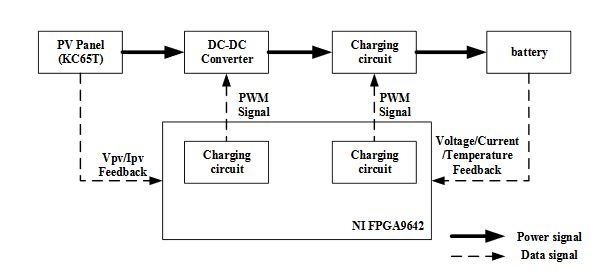ABSTRACT
This study used a field-programmable gate array (FPGA) with a Xilinx Spartan-3 FPGA to implement Reflex charge control in a dual-axis solar tracking system with maximum power point tracking (MPPT). The chaos embedded particle swarm optimization method was used to search for the optimum gain constants of the PI controller and the Reflex charging frequency.
This scheme not only increases the output power of solar panels but also has a significant effect on switching loss and oscillation of solar charging. The experiment results showed that the proposed method can also significantly improve temperature rise, and that charging efficiency is also better than it is in a traditional charge mode. The results also showed that charging power was enough for solar tracking and the requirements of the charging system. The most significant contribution of this paper is that the scheme can be applied to any active solar tracking and charging system.
Solar Energy Charging System Design

Figure 1. Schematic diagram of the solar power system circuit
The aim of the solar energy charging system was the storage of energy in the reserve battery, as shown in Figure 1. In this study, a NI Single-Board RIO device (FPGA 9642) (Xilinx, San Jose, CA, USA) was used as a controller to implement the control scheme. The NI sbRIO-9642 device features an industrial Freescale MPC5200 real-time processor with speeds up to 400 MHz for deterministic real-time applications.
OPTIMIZATION ALGORITHM

Figure 3: PSO flow chart
In velocity-updating Equation (2), the PSO is used to find a current optimal solution of each particle iteratively, set as pbest here. When the iteration of all particles is finished, an optimal solution can be found, set as gbest. The position updating is expressed in Equation (3), the initial position of each particle. Figure 3 is the PSO flow chart.
SIMULATION AND EXPERIMENT RESULTS

Figure 8: Temperature rise curve comparison diagram
The data shown in the various figures were recorded once every 2 s, and 30 min of charging was drawn into a single curve instantly. The experiment results focused on the temperature in different charging modes. It can be seen in Figure 8 (the temperature curve comparison diagram) that the CV increases by 4°C–5°C and continuously in the case of low current.
Self-Sufficient Power Supply Evaluation

Figure 9. Schematic diagram of battery operation
When the solar energy charging system was completed, the availability of the equipment used for the solar tracking system was investigated. Figure 9 shows the external power supply used in this study. First, for the lead-acid battery (charging and equipment power supply are individual batteries), a DC-DC converter was used to increase the voltage from 12 V to 24 V for the solar tracking equipment.
CONCLUSIONS
The self-sufficient solar power generation system proposed in this study uses a combination of solar tracking with MPPT and battery charge control. The study focused on temperature suppression and self-sufficiency of the supply. The results showed that the optimum frequency simulated in this study can improve the battery temperature considerably.
In terms of common solar charge strategy, the temperature difference between CV charging and the CV-Reflex charging achieved in this study was 2°C–3°C, and temperature suppression is more apparent when the reflex is switched. This demonstrated that this system can be effective in the suppression of battery temperature rise and can help avoid the rapid aging of the battery. The final results also show that the proposed system can be self-sufficient.
Source: National Chin-Yi University
Authors: Jui-Ho Chen | Her-Terng Yau | Jin-Han Lu